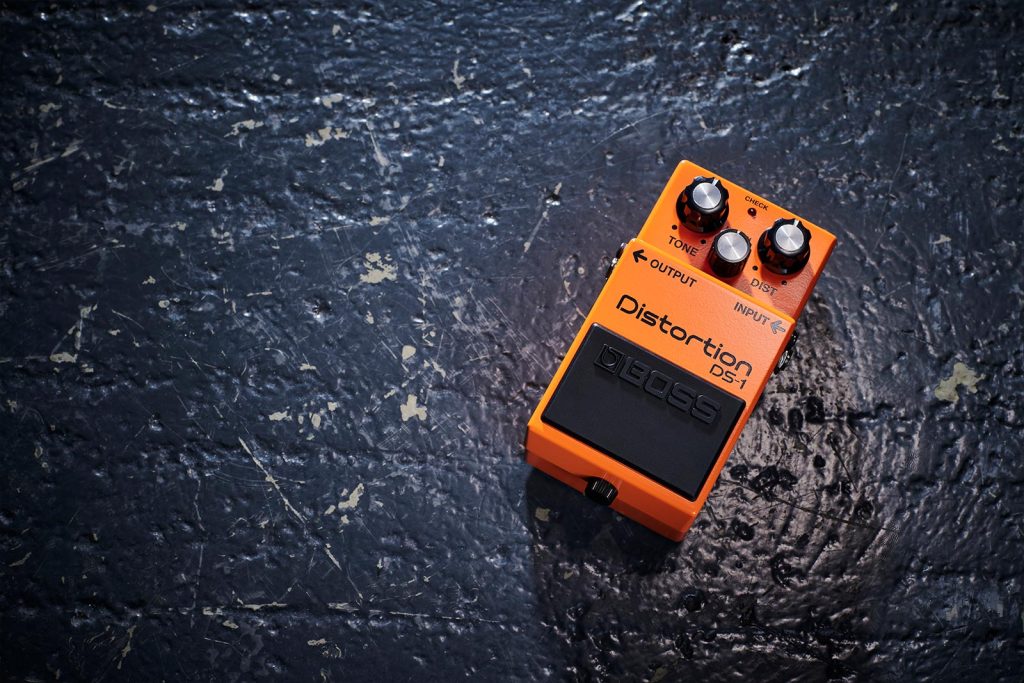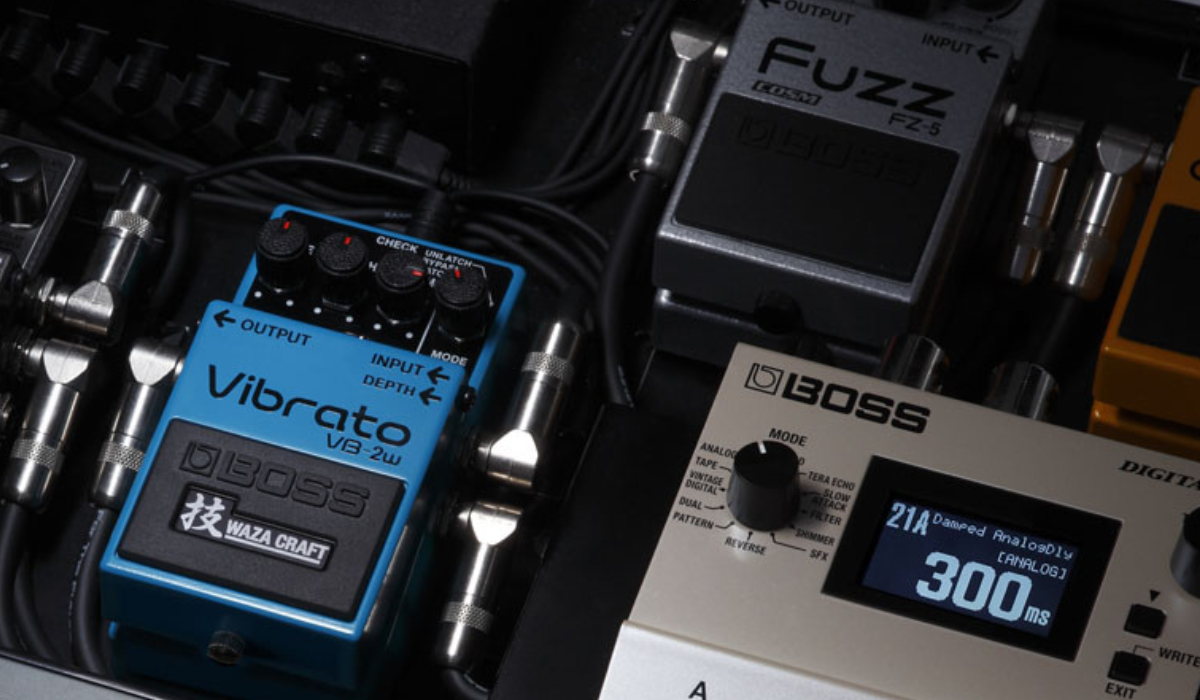For an effect first created to emulate the sound of actual rhythmic note bending on a guitar, the vibrato pedal has come a long way. Vibrato is a versatile tool that works for everything from gentle chorus to extraterrestrial sounds. The range of its sonic capabilities is vast enough to make vibrato the ideal modulation pedal to pair with other effects. Learn to create wild new tones and tasteful classics with vibrato.
Setup Considerations
The vibrato effect’s versatility means it can sit in many different positions on a pedalboard. Vibrato is commonly considered part of the modulation effect family. So like chorus, phaser, flanger, and tremolo, vibrato should get placed roughly in the middle of the pedalboard layout.
Compressors, overdrives, and EQ pedals should come before vibrato. This allows it to affect the signal those more simple effect types create. On the other hand, delays and reverbs should get positioned after vibrato, leaving their delay tails or echo as the finishing touch to your sound.
"The vibrato effect’s versatility means it can sit in many different positions on a pedalboard."
However, vibrato can also be very effective in an amplifier’s effects loop ahead of delays and reverbs. Positioning the pedal after the preamp is ideal for maintaining crisp modulation tones. This way, they don’t become muddied by the gain stage.
Additionally, some players prefer to position the vibrato ahead of overdrives on their pedalboard. Vibrato is technically a pitch-based effect. So, depending on the intended application of the pedal, it can be in the same place as octave pedals and other pitch-shifting type effects.
PEDAL COMBINATIONS
Overdrive
A wonderfully simple solution that excites and enhances a heavy guitar tone is the pairing of overdrive and vibrato. These two effects, used together, turn riffs and progressions into colossal, spooky soundscapes. Even more interesting about this pairing is that they can work well, but differently, in either order on a pedalboard.
Running a simple, thick overdrive into a vibrato pedal allows the vibrato to act partially as a boost. This approach lifts the guitar signal in the mix and propels it to the front and center of any musical piece. In this case, the vibrato acts like a chorus. Keep the depth control below 12 o’clock and the rate around 1-2 o’clock for a simple chorus-like boost to the drive tone.

Positioning vibrato ahead of overdrive will create a soupier, darker tone. This placement is ideal for moody melodies and slow-moving drone progressions. With the pedals in this position, keep the depth control around 12 o’clock. At the same time, back the rate control off to around 8-9 o’clock for a slow, dreamy movement to the progression.
Recommended Pairings
- BOSS VB-2W and DS-1
- BOSS VB-2W and BD-2W
"Positioning vibrato ahead of overdrive will create a soupier, darker tone. This placement is ideal for moody melodies and slow-moving drone progressions."
Cocked Wah
Vibrato can be a fantastic effect for emulating a lo-fi tape recorded-style indie guitar tone. But, to bring that tone to life, it must get coupled with either a cocked wah-type pedal, an actual wah in a fixed position, or an overdrive. Ideally, the overdrive should have three bands of EQ to remove the bass and treble frequencies and boost the mid frequencies.
The nasal sound of the cocked wah is very lo-fi. With a vibrato, it can sound almost like the warble of a warped record through poorly connected speakers. Listen to Mac DeMarco’s opening track on 2, “Cooking Up Something Good,” for a great example of thin, warbly vibrato tones.
Dial the rate almost to its lowest setting to achieve this effect, but boost the depth to around 3 o’clock. The result will be a slowly warping, harsh, nasal vibrato/cocked wah blend—perfect for intros, outros, and interludes.
Recommended Pairings
- BOSS VB-2W and PW-3
- BOSS VB-2W and AW-3
"Running a simple vibrato into a rich, decaying reverb can be a fantastic way to add movement to ethereal soundscapes."
Reverb
Running a simple vibrato into a rich, decaying reverb can be a fantastic way to add movement to ethereal soundscapes. This combination works well with a slow rate setting on the vibrato. The shifting pitch movement from the vibrato can create an interesting tone. Depending on how thick and overpowering the reverb setting is, the vibrato depth can get pushed to its extreme.
Recommended Pairings
- BOSS VB-2W and RV-6
- BOSS VB-2W and RV-500

Delay
Vibrato is the perfect partner for lush ambient delay effects. The combination is an effective way to lift cascading ambient guitar movements to new heights. In many ways, this works similarly to pairing vibrato with reverb. But in this case, the delay should come ahead of the vibrato. This approach also works well with a slightly driven amplifier.
In this case, think of the vibrato pedal as an old tape deck playing back the ambient guitar part imperfectly. Adding a driven amplifier replicates the grit of the tape deck’s preamp. We can also achieve this by running an overdrive last in the chain after the delay and vibrato. In this setting, as with reverb, set the vibrato rate extremely slowly. Push the depth control to a point where the shifting pitch of the vibrato is audible but not overpowering.
Recommended Pairings
- BOSS VB-2W and DM-101
- BOSS VB-2W and RE-202
"Vibrato is the perfect partner for lush ambient delay effects. The combination is an effective way to lift cascading ambient guitar movements to new heights."
Modulation that Goes Further
Vibrato is one of the more extreme-sounding modulation effects. It can create everything from wild recording effects to chorus-like thickening to a guitar tone. It works in various places on a pedalboard to create unique sounds and plays well with everything from a simple overdrive to an octave, fuzz synth cocktail of effects. This is the perfect tool for guitarists looking for a modulation tool that goes slightly further than most.






